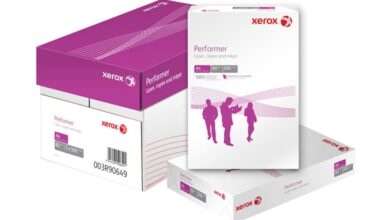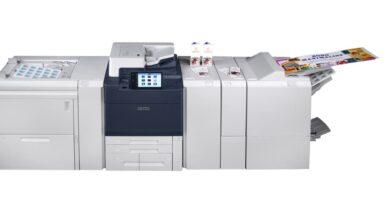Xerox launches Mid Entry Digital Press
Just when you thought the market is saturated with all kinds of digital presses Xerox surprises everyone and launches an all new Xerox’s mid entry digital press dubbed as Versant 2100. The new digital press is already available in the Middle East. While it faces tough competition from likes of Konica Minolta and Ricoh the new Versant 2100 certainly raises the bar on mid entry digital press. It can print up to 100 ppm on substrates as heavy as 300 gsm and up to 80 ppm on substrates as heavy as 350 gsm. The machine has been developed by fujiXerox in Japan and it benefits from highly successful color 800/1000 print engine design and VCEL ROS imaging technology. Using Emulsion Aggregation (EA) Dry Ink the machine offers high quality 2400 x 2400 dpi images. However the machine has a native 1200×1200 dpi renderer. The Versant 2100 comes with two DEF options; the new Xerox FreeFlow FE or a Fiery from EFI. Both options use Adobe PDF engine (APPE3) and support all the major variable data formats including PDF/VT as well as the new Xerox Stock Library Manager. The stock library Manager handles a wide range of media including coated and uncoated papers, bright papers, labels, business cards, glossy brochures, window decals, durable/synthetic papers, greeting cards, tabs, embossed, polyesters and custom solutions from 52 Bond to 350 gsm Cover.
 Versant’s other important features include Production Accurate Registration (PAR) for consistent front-to-back registration, Auto-Tray Switching, Auto Sheet Clearing and Reload-While-Run Capability which keep press running to produce more jobs.
Versant’s other important features include Production Accurate Registration (PAR) for consistent front-to-back registration, Auto-Tray Switching, Auto Sheet Clearing and Reload-While-Run Capability which keep press running to produce more jobs.
“We have always been strong in hardware, IT and document management and we are still hugely involved in hardware market. After all we invented this marketplace and we are still a premium provider,” Comments Dan Smith, head of Integrated Marketing for the Middle East and Africa region of Xerox’s Developing Markets Operations. Smith has a point. It was Xerox who launched first digital production machine almost quarter of century ago. For almost a decade Docutech machine was unrivalled. But now we are facing a different scenario. The market is awashed with all kinds of presses that can satisfy almost any demand for quality printed products. Smith believes Xerox brand is powerful enough to attract customers.” Xerox brand perceived well globally and regionally. We have a strong pedigree in digital printing technology and people are aware of our legacy to innovate and bring state-of-the-art equipment to the market”.
This statement might be true as far as electrophotographic devices are concerned but within realm of inkjet Xerox has definitely some catching up to do. “We are quite aware of inkjet’s massive future opportunities. That’s why we bought Impika. We are looking to promote aggressively our inkjet portfolio in the Middle East. We already introduced IJP 2000 wide format inkjet printer which is one of the fastest poster printers in the market. It’s capable of speeds of up to 420 m2/hr. (4,520 ft2/hr). With this speed, machine can churn out a colorful poster in 5 seconds. The sweet spot for IJP technology is high frequency printing for retail outlets. We already sold four units to customers in the region. We are now actually offering a complete portfolio of inkjet presses to the market.” Explains Smith.
Xerox acquired Impika in 2013. Impika offers a portfolio of aqueous (water-based) inkjet presses based on proprietary technology. Impika product lines include iPrint™, a range of continuous feed production printers that print at speeds as fast as 375 meters per minute, and iPress™, a range of graphic communications digital presses with resolutions of up to 2400 x 1200 dpi. Impika, based in Aubagne, France, sells its products to print providers through its direct sales force and through a global network of channel partners, including Xerox, which has been reselling the Impika brand in Europe since 2011, and recently expanded to several developing markets including Middle East.
Xerox is now working to push this technology to the Middle East markets.” Impika equipment is advanced and highly productive. However before any implementation we have to make sure our customers have the capacity and resources to use the machine. Poor implementation is ultimately bad for vendor and buyer. Currently we are talking with Xerox customers who are using cut sheet products and discuss with them the possibility of switching to digital inkjet. At the same time we are targeting companies and potential customers that we haven’t been engaging so far,” concludes Smith.

.gif)



